The little horseradish 1x1
Botanical classification
Horseradish is also known by its Latin name, "Armoracia rusticana," and is a root perennial well-capable of withstanding winter weather belonging to the cruciferous plant family (Latin Cruciferae).
History
The "overseas radish," which was brought to us from western Asia over southern Europe in the 9th century, is one of the strongest spices (which, from an etymological point of view, lead to its German name, which is roughly translated as "more radish), but it is not actually a radish by botanical definition. Like radish, however, it belongs to the same family as turnips, cabbage and mustard (French Raifort = strong root; English horseradish from the old word 'hoarse/coarse,' or spicy radish). Another source for the name comes from the German word 'Maehre' (=horse), in which case the modern German name would have to be 'Pferderettich,' which translates directly as "horse-radish," and sheds light on the English name.
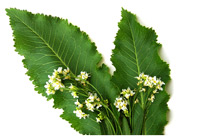
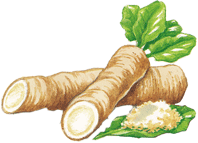
Areas of cultivation
For decades Hungary is the largest traditional horseradish producer in Europe. Further important cultivation areas are in Austria, Germany and Poland.
Cultivation
Well-grounded, medium-dense and clay-rich soil with a sufficient supply of water is best for the cultivation of horseradish.Planting takes place in Spring with the placing of seedlings. The seedlings are secondary roots approx. 0.5 to 1.5 cm strong, which are separated from the main root at harvest in the Fall and trimmed to approx. 30 cm in length.
Between mid-April and mid-May the seedlings are brought to the fields and placed in approx. 10 cm deep furrows with 60 to 80 cm of space between each seedling and covered with soil.
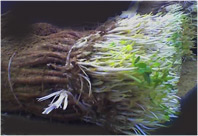

Care
Caring for the horseradish roots requires a lot of hand work. All head-shoots are removed from the main root approx. 4-6 weeks after setting the seedlings. This prevents the development of
"multi-headed" roots, as the industry generally requires the horseradish be "single-headed."
In order to produce the smoothest roots possible and to prevent root stocks, the roots are exposed around the start of July and lateral shoots removed with a knife. The roots are then once again covered with soil. Depending on the amount of rain the soil may need to be loosened to prevent incrustation and weed growth. At present mineral fertilisers, sometimes combined with stall manure, are used to fertilise the soil.
Harvest
The main harvest begins around the middle of October. Horseradish can be left in the ground until Spring as it is frost-resistant. Special ploughs are used to remove the roots from the ground.
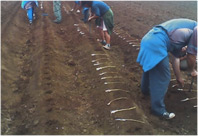
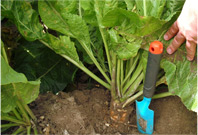
Health-related aspects
Horseradish has been highly regarded as a spice and medicinal plant for centuries. With its 114 mg per 100 g it has twice as much Vitamin C as a lemon (100 g are enough to meet the daily requirement, which is why it is also referred to as the "Bavarian lemon"). It also contains physiologically-important minerals and trace elements. It's strong taste can be traced to its essential oils. The substances allicin and sinigrin, which are found in horseradish, have an anti-bacterial effect. This explains why horseradish is sometimes referred to as "German penicillin" and used in medicine, e.g., in treating colds and intestinal infections. The appetite-stimulating effect of horseradish is also well-known.
Recommendations
Horseradish goes great with smoked and grilled foods, eggs and in salad dressings; it is also used as a spice in preparing mixed pickles, mustard pickles and other delights. It can be combined with fruit to milden the spicy taste; apple horseradish is an absolute must alongside boiled beef. You can find tips for recipes at: www.scandia.de
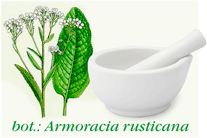

Avg. nutritional values
Trace elements, minerals
and vitamins:
Protein: 2,8 g
Usable carbohydrates: 11,7 g
Fiber: 3,6 g
Sodium: 9,00 mg
Iron: 1,40 mg
Potassium: 554,00 mg
Phosphor: 65,30 mg
Magnesium: 33,00 mg
Calcium: 105,00 mg
Vitamin B1: 0,14 mg
Vitamin C: 114,00 mg
